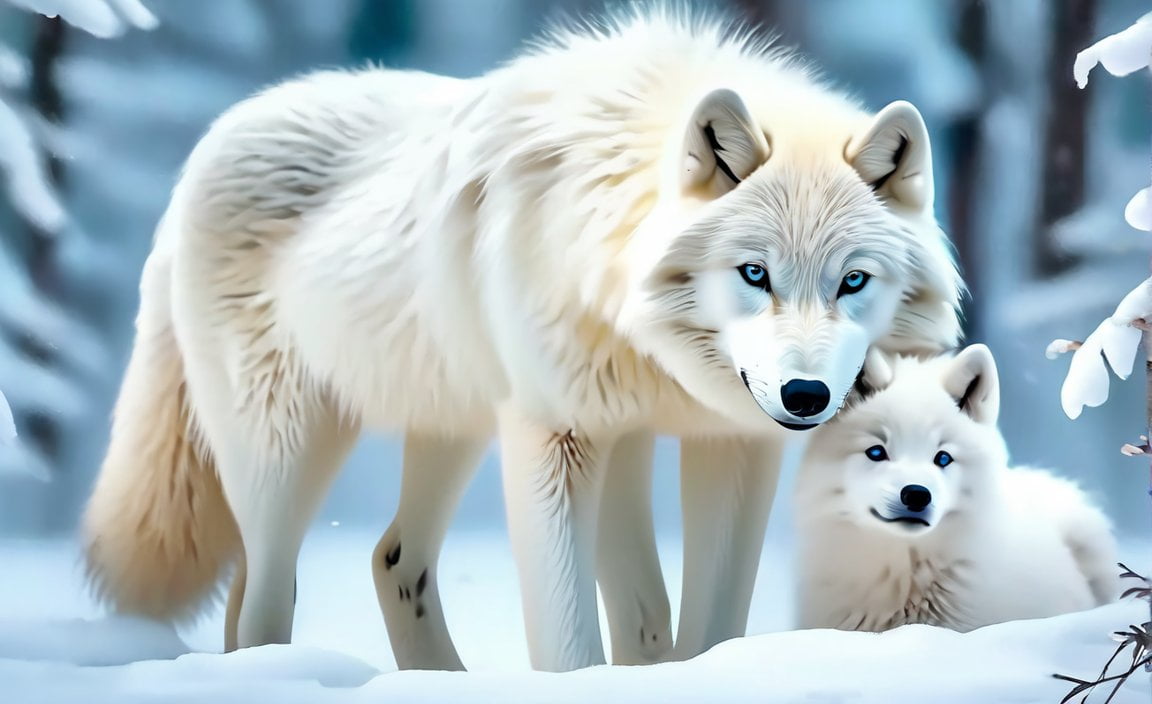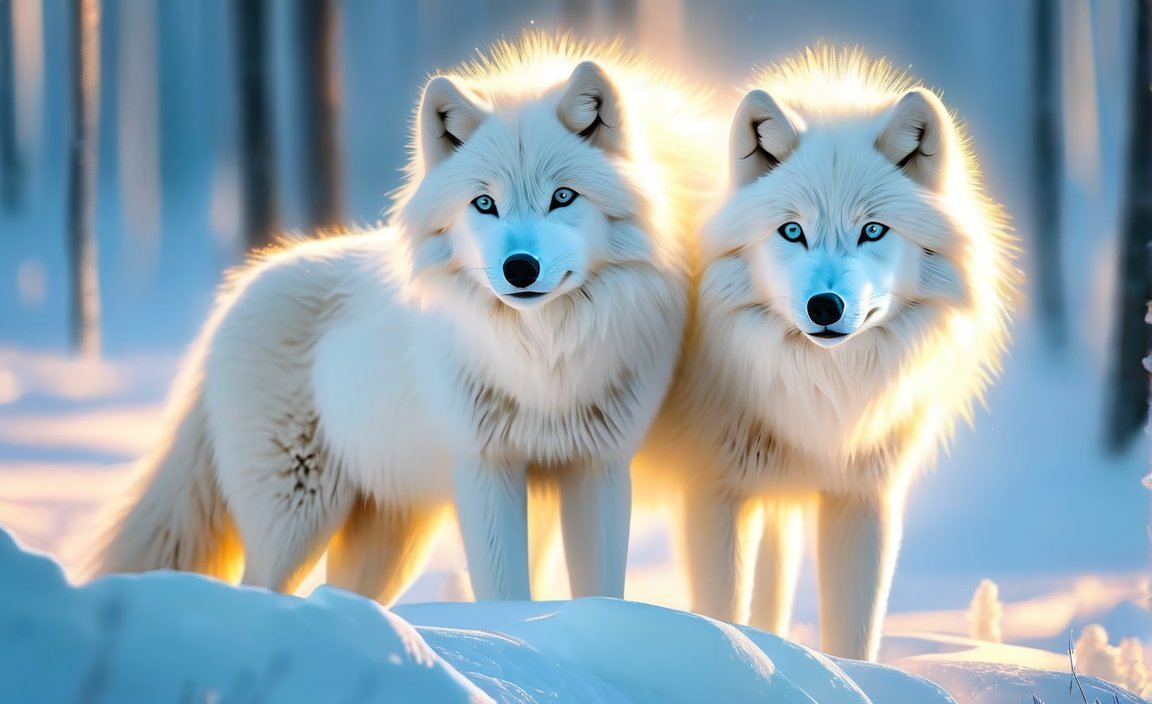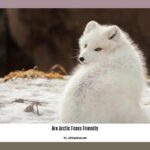Get ready to discover the thrilling world of Arctic wolves, the enigmatic hunters of the frozen wilderness. These fascinating creatures, also known as polar wolves or white wolves, are a subspecies of gray wolves that have adapted to the unforgiving conditions of the Arctic tundra. Embark on an icy adventure as we unveil 10 jaw-dropping facts that will immerse you in their remarkable adaptations, captivating social dynamics, and the vital role they play in the delicate Arctic ecosystem.

10 Fun Facts About Arctic Wolves
Imagine a place so cold your breath freezes instantly. Now, picture a wolf, its coat as white as the snow beneath its paws, perfectly at home in this icy world. That’s the Arctic wolf, a creature that embodies the wild beauty and harsh realities of the Arctic. Ready to dive into their world? Here are 10 fascinating facts about these incredible canines!
1. Built for the Big Chill:
Have you ever complained about a winter coat being too warm? Arctic wolves would laugh (or maybe howl) at that! Their double-layered fur is so thick and insulating that they can comfortably handle temperatures that would send shivers down a polar bear’s spine – we’re talking a bone-chilling -60 degrees Fahrenheit!
2. The Pack is Mightier Than the Lone Wolf:
While some Arctic wolves prefer to roam solo, many band together in packs, usually with up to six members. These aren’t just random groups either; they’re highly organized, with each wolf having a specific role. It’s like a family business, but instead of selling insurance, they’re experts at surviving the Arctic!
3. Hunting with Finesse:
Picture this: a pack of Arctic wolves on the hunt. They communicate silently, their movements coordinated, their senses razor-sharp. These wolves are masters of teamwork, bringing down prey much larger than themselves through strategy and coordinated attacks. It’s a sight that highlights both their intelligence and their ability to thrive in a challenging environment.
4. Wanderlust on Four Legs:
Forget road trips; Arctic wolves are all about those epic Arctic journeys! These nomads can travel vast distances in search of food, their paws covering miles upon miles of icy terrain. Their ability to adapt to the ever-changing conditions of the Arctic is truly remarkable.
5. More Than Just a Howl:
Sure, their howls echo across the frozen landscape, but Arctic wolves have a whole communication system beyond a good howl. Think body language, scent marking, and a whole range of vocalizations that would put a dog whisperer to shame!
6. An Arctic Menu:
What’s for dinner in the Arctic? For these wolves, it’s a menu that reflects the challenging environment. Think caribou, musk ox – even smaller mammals when times are tough. Their diet is a reminder of the delicate balance of life in this extreme environment, where survival depends on making the most of every opportunity.
7. Masters of Disguise:
Talk about blending in! With their pristine white coats, Arctic wolves are practically invisible against the snowy backdrop. This camouflage is crucial, helping them sneak up on prey and avoid becoming another predator’s meal.
8. Every Feature Tells a Story:
From their thick fur to their compact bodies, Arctic wolves are perfectly adapted to conserve heat. Their proportionally smaller ears and muzzles mean less surface area for heat to escape, a crucial advantage when you live in a land of perpetual winter.
9. Brains and Brawn:
Don’t let their wild nature fool you; Arctic wolves are incredibly intelligent. They’re known for their problem-solving skills, adaptability, and resilience – all essential traits for thriving in one of the harshest environments on Earth.
10. Guardians of the Frozen North:
As apex predators, Arctic wolves play a vital role in maintaining the delicate balance of the Arctic ecosystem. They help keep prey populations in check, ensuring the health and stability of their icy kingdom.
If you’re fascinated by sea creatures, you wouldn’t want to miss these 10 facts about sea creatures. Dive into the incredible world underwater and discover some mind-blowing information. Ready to explore? Click here to unveil the secrets of the deep sea.
Did you know that worms play a vital role in our ecosystem? Learn all about these fascinating creatures with our collection of 10 facts about worms. Click here to discover how worms benefit our planet and the intriguing details about their unique characteristics.
Cats are truly remarkable animals, and we’ve compiled a list of 10 fascinating facts about cats that will leave you in awe. From their exceptional agility to their mysterious behaviors, these facts are a must-know for any cat lover. Don’t miss out, click here to uncover the secrets of our feline friends.

What are Some Fun Facts About Arctic Wolves?
Okay, so we know Arctic wolves are built to handle some serious cold, but did you know they’re smaller than other wolves? It’s true! Their compact size, with shorter legs and a less pointy snout, helps them stay warm in those freezing temperatures. Plus, it makes them super agile when navigating icy terrain.
Now, let’s talk about communication. These guys are the chattiest of wolves! They’re famous for their haunting howls, which they use to keep in touch over long distances. Imagine trying to find your friends in a blizzard – good thing they can howl and get everyone back together!
Speaking of staying warm, have you seen their coats? Talk about cozy! Arctic wolves rock a double layer of fur so thick and insulating it makes a down jacket look like a t-shirt. And get this: their coat color changes with the seasons. Sometimes it’s bright white, blending in with the snow, and other times it’s more of a bluish or grayish hue, helping them camouflage against rocks and shadows. Sneaky, right?
But here’s the thing about Arctic wolves – they’re always on the move. We’re talking hundreds of miles of travel in search of food. These guys are expert hunters, and their menu changes depending on what’s available. Caribou, musk oxen, even smaller mammals – if it moves, there’s a chance an Arctic wolf might try to make a meal of it.
It’s mind-blowing how these incredible creatures thrive in one of the harshest environments on Earth. They’re a true testament to the power of adaptation and resilience.
Want to learn more? Check out this Arctic Wolf Facts page. It’s packed with cool information!
What are 10 Interesting Facts About Wolves?
We’ve already learned a bit about these amazing Arctic wolves, but there’s so much more to discover! Let’s dive back in and uncover some more fascinating tidbits about these incredible creatures of the icy north.
- Imagine living in a world of white! Arctic wolves, unlike their gray cousins, often have a bright white coat. This helps them blend seamlessly into the snowy landscapes where they live, making it easier to sneak up on their prey – talk about camouflage skills!
- Ever wonder how big these wolves can get? Well, an adult Arctic wolf can grow to be about 3 to 6 feet long, from nose to tail. That’s like trying to fit your bed lengthwise in a small car! And when they stand on their hind legs, they can be almost as tall as an average person.
- You might think their white fur means they’re not as warm, but that’s not true at all! Arctic wolves have not one, but two layers of thick fur. This amazing insulation helps them stay toasty warm, even when temperatures plummet to ridiculously cold levels. We’re talking -76 degrees Fahrenheit! That’s even colder than your freezer. Brrr!
- Family matters a lot to these wolves. Arctic wolves live in packs that can be as small as a handful of individuals or as large as 20 wolves. These packs are usually led by a dominant male and female, who are like the ‘mom’ and ‘dad’ of the group, and they’re the ones who primarily mate and have pups.
- Speaking of pups, Arctic wolf families are pretty tight-knit. The young ones usually stay with their parents for at least a year, sometimes even longer! During that time, they learn all the important wolfy things, like hunting strategies and how to survive in their harsh environment. It’s like going to the best school ever, but for wolves!
- Ever wonder what’s on the menu for an Arctic wolf? Well, they’re carnivores, which means they primarily eat meat. These skilled hunters often go after musk oxen – big, shaggy creatures that also brave the Arctic. They also hunt caribou, lemmings, arctic hares, and even seals sometimes!
- Scientists believe that Arctic wolves don’t have as many encounters with people compared to other wolf species. This is largely because they live in such remote and sparsely populated areas. So, while we find them fascinating, they haven’t had as much interaction with humans as some other wolf types.
- While they are powerful predators, Arctic wolves do have some rivals in the wild. Polar bears, for instance, sometimes compete with them for food and resources. It’s a tough neighborhood up there in the Arctic!
- Climate change is a big concern for Arctic wolves. As temperatures rise and ice melts, it impacts the availability of their prey and their hunting grounds. Scientists are actively studying how these environmental changes are affecting Arctic wolf populations and their future.
- There’s still so much we can learn from these amazing creatures! Researchers continue to make fascinating discoveries about Arctic wolves, their behavior, and how they’re adapting to our changing world. It’s a reminder that the animal kingdom is full of surprises!
Why are Arctic Wolves Special?
So, we’ve talked about how tough these Arctic wolves are, but what makes them stand out even among wolves? Well, for starters, their coats are way thicker than their grey wolf relatives. It’s like wearing a super-warm parka all the time, perfect for those freezing Arctic temperatures that can drop to -30 degrees Celsius! Can you imagine living in that kind of cold?
These wolves are tough cookies, built to handle conditions that would send other animals running for shelter. They’re compact, with shorter legs and smaller ears and noses, all designed to help them conserve heat. They’re basically experts at navigating that icy world without losing precious body heat.
And where do these resourceful wolves make their homes? They find caves carved out by the powerful Arctic ocean and turn them into cozy dens. Talk about beachfront property! These dens become their safe havens, protecting them from the worst weather the Arctic can throw at them.
But here’s the really cool part: their iconic white coats. It’s not just about looking cool in the snow, though that definitely helps. Their coats, which can range from pure white to bluish or greyish, provide amazing camouflage against the snowy backdrop of their environment. It’s like their own invisibility cloak, helping them sneak up on prey and avoid becoming someone else’s lunch.
Scientists believe this remarkable adaptation is the result of years and years of evolution, shaping them to thrive in one of the harshest environments on Earth. They’re a true testament to the power of nature to adapt and overcome challenges.
Key Takeaways:
- Arctic wolves are built for warmth! Their thick double coats and unique physical features make them masters of insulation in the Arctic cold.
- These wolves are experts at adapting to their surroundings. They use ocean-carved caves as dens, shielding themselves from the elements.
- Don’t let their smaller size fool you; these wolves are built to handle extreme conditions. Their compact bodies, shorter limbs, and smaller ears and muzzles all play a role in conserving heat.
- Their white coats are their secret weapon, providing amazing camouflage in the snowy landscapes they call home. This helps them hunt effectively and avoid danger.
Source:
Do Arctic Wolves Have 42 Teeth?
We’ve already talked about a bunch of cool stuff about Arctic wolves, but let’s dive into something else that makes them such amazing predators: their teeth! You bet they have a mouthful – a whopping 42 teeth, in fact! That’s about the same as your average dog, but trust me, these aren’t your grandma’s poodle teeth. We’re talking serious chompers designed for surviving in one of the harshest places on Earth.
So, what’s so special about 42 teeth? Well, for starters, these aren’t just any teeth; they are super sharp and strong. Think about it: Arctic wolves live in a frozen wasteland where food can be scarce. They need to make the most of every meal, and that means being able to tear through thick fur, tough hide, and even crush bones to get to the good stuff. Their teeth, combined with incredibly powerful jaw muscles, give them a bite force of up to 600 pounds per square inch (psi). To put that in perspective, that’s like having a small car sitting on your dinner!
Just like a mechanic has the right tools for the job, each tooth in an Arctic wolf’s mouth has a specific purpose. They have sharp incisors in the front for snipping and tearing smaller pieces of meat. Their canines – those pointy ones that look like fangs – are what they use to grab and hold onto their prey, like a muscular caribou or a slippery seal. And then there are the premolars and molars in the back, which act like scissors and grinders, perfect for shredding meat and crushing bones.
Scientists have learned a lot about how animals have adapted to their environments by studying their teeth. It’s like piecing together a puzzle. The number, shape, and even the wear patterns on an animal’s teeth can tell us a lot about what they eat, how they hunt, and even how they fit into the ecosystem.
While we know a good deal about Arctic wolves and their impressive dental work, there’s always more to learn. Researchers continue to study these fascinating creatures, and new discoveries might change how we understand their teeth and how they use them. So, keep your ears perked and your eyes peeled – the Arctic might have more secrets to reveal about its top predator!
What are 15 Facts About Wolves?
We’ve already dipped our toes into the captivating world of wolves, but trust me, there’s still a whole lot more to discover about these incredible creatures. Hold on tight, because we’re diving deeper into 15 fascinating facts that just might surprise you!
- The top dogs: Forget your average Fido, wolves take the crown as the largest members of the dog family. We’re talking about some seriously impressive canines!
- Pack life: Wolves are all about family, living in tight-knit packs typically consisting of 6-10 individuals. However, scientists have observed packs with a whopping 30 wolves – talk about a full house!
- Home turf: Just like we have our favorite spots, wolves are fiercely protective of their territory. They’ll stand their ground and defend it against any rival wolf packs that dare to intrude.
- Kings and queens of the food chain: Wolves sit right at the top as apex predators. This means they play a crucial role in keeping ecosystems in balance by regulating prey populations.
- Meat is on the menu: As carnivores, wolves have a diet primarily composed of deer, elk, and moose. Think of them as nature’s very own expert hunters, keeping those herbivore populations in check.
- Speaking wolf: Ever wonder how wolves chat with each other? They’ve got their own complex language system that involves a fascinating mix of howls, growls, body language, and even scent marking.
- Brainpower: Don’t underestimate the intelligence of these wild canids. Studies suggest that wolves can solve problems, learn from their past experiences, and even outsmart their prey. Talk about being clever!
- Playtime!: Wolves aren’t all business; they know how to have a good time too! Whether it’s roughhousing with their packmates or engaging in playful antics with their pups, these social butterflies understand the importance of a little fun.
- Loyalty runs deep: Wolves form incredibly strong bonds with their pack members, demonstrating remarkable loyalty and cooperation. They rely on each other for survival, creating a powerful social structure.
- Ecosystem superheroes: Wolves are essential for maintaining the health and balance of their ecosystems. By keeping prey populations in check, they indirectly benefit plant life and other animal species.
- A threatened reality: Sadly, wolves face numerous threats in many parts of the world, including habitat loss and hunting. Fortunately, they’re protected under the Endangered Species Act in the United States, offering a glimmer of hope for their future.
- Keystone species: Wolves are considered a keystone species, meaning their presence has a ripple effect throughout their entire ecosystem. Their impact extends far beyond just the animals they prey on, influencing everything from plant diversity to soil health.
- Symbols of strength: Throughout history, wolves have held a special place in human culture, often symbolizing strength, courage, and loyalty. Their captivating presence continues to inspire awe and wonder.
- From myths to movies: Wolves have prowled their way into our myths, literature, and films for centuries, captivating our imaginations with their wild spirit and enigmatic nature.
- A sight to behold: There’s nothing quite like witnessing the raw beauty and power of wolves in their natural habitat. These majestic creatures remind us of the untamed wilderness that still exists in our world.
Keep Exploring!
The world of wolves is vast and full of ongoing research. New discoveries about their behavior, social dynamics, and ecological importance are constantly being made. Don’t let your curiosity end here – keep exploring!
What are 5 Interesting Facts About Arctic Foxes?
We’ve already talked a bit about these cunning creatures, but there’s so much more to learn about Arctic foxes. They’re not just survivors in a land of ice and snow—they’re downright fascinating! Let’s dive into some more surprising facts about these fluffy denizens of the Arctic.
1. Could Arctic foxes be the ultimate fur coat wearers?
Okay, we wouldn’t recommend wearing fur, but Arctic foxes have evolved the densest fur of any mammal on Earth! That’s quite an accomplishment. They’ve got this double-layered system going on – a long, thick outer layer and a super soft, dense inner layer. It’s like wearing a down jacket under a fur coat, making them supremely equipped to handle those bone-chilling Arctic temperatures, even when the mercury dips way below freezing!
2. Fashion chameleons of the Arctic!
We know, changing coats with the season is so last year. But for Arctic foxes, it’s a matter of survival! These clever canids sport a pristine white coat in winter, blending seamlessly with the snowy landscape. Come summer, they transition to a brown or grayish coat, helping them disappear amidst the rocks and tundra vegetation. This color-changing ability makes them masters of camouflage, perfect for sneaking up on prey or hiding from predators.
3. Family comes first, even in the Arctic.
Arctic foxes are very family-oriented. They live in dens with their little (or sometimes not-so-little) families. These dens are typically found in burrows or caves, offering a cozy refuge from the harsh Arctic winds and freezing temperatures. It’s also where they raise their adorable pups, teaching them the ways of the Arctic.
4. Not picky eaters; a little bit of this, a little bit of that!
Living in the Arctic means you can’t be a picky eater, and Arctic foxes take that to heart! These resourceful predators are opportunistic omnivores. Their diet reads like a “what’s available” menu, from lemmings and voles to birds, eggs, fish, and even berries and seaweed when times are tough. Sometimes, they even scavenge leftovers from larger predators like polar bears – talk about a free meal!
5. Built for the cold, inside and out!
Arctic foxes haven’t just adapted to survive the cold; they’ve practically mastered it. Their compact bodies, with those short legs and ears, minimize heat loss. And that luxurious, bushy tail? It’s not just for show! They use it as a cozy blanket, wrapping it around themselves for extra warmth. They even have a special layer of fat under their skin for insulation. These adaptations make them perfectly suited for thriving in a frozen world.
Arctic foxes are an incredible example of adaptation and resilience. They’ve not only survived but thrived in one of the most extreme environments on our planet. Studying these fascinating creatures helps us understand the incredible diversity of life on Earth and how animals adapt to even the most challenging conditions. While we continue to learn about them, we must also work towards protecting them and their fragile Arctic home.
How Rare is the Arctic Wolf?
We’ve already talked about how cool Arctic wolves are, but just how rare are these icy canines? Well, they’re not as common as your average gray wolf, that’s for sure. Imagine a map of the world; now picture a tiny sliver at the very top – that’s basically where these guys hang out. We’re talking about the northernmost parts of North America and Greenland, a pretty limited range. Sadly, their numbers have been shrinking because of things like habitat loss (humans taking over their homes), climate change (messing with their food supply), and, unfortunately, hunting.
So, while we don’t have an exact headcount, it’s safe to say these wolves are definitely not a dime a dozen. Scientists are constantly studying their populations, and it seems like their numbers are low enough to be a real concern. This is why groups like Defenders of Wildlife are working hard to protect them. They’re considered an endangered species, which means they’re at risk of disappearing completely if we don’t give them a helping paw.
Can Arctic Wolves Have Blue Eyes?
We’ve already talked about how striking Arctic wolves are with their bright white coats, perfectly blending into their snowy surroundings. But did you know that some of these wolves have a secret weapon for looking even cooler? Yep, I’m talking about blue eyes!
While it’s not super common, a small number of Arctic wolves keep their baby blues even when they’re all grown up. Most of their relatives end up with golden or amber eyes, which look pretty awesome too. So, what makes these few wolves rock the blue-eyed look? Scientists believe it comes down to a particular gene they inherited from their parents. This gene, which is a bit like a hidden talent, affects how much melanin they have in their bodies. Melanin is like nature’s coloring book, deciding everything from skin tone to eye color.
Now, you might be wondering how common this “blue-eyed gene” is. Well, that’s where things get really interesting. Unlike humans, where blue eyes tend to run in certain families or groups, for Arctic wolves, it seems to pop up randomly. This tells us that the way blue eyes are passed down in wolves is different from how it works for us.
There’s also a big question that scientists are trying to figure out: Why blue eyes at all? Some think it might give the wolves an extra edge when hunting. Imagine being a seal just chilling on the ice, and suddenly, a pair of icy blue eyes appear out of nowhere – talk about a camouflage superpower! Of course, this is just a theory, and researchers are still piecing together all the clues to understand the real benefit of blue eyes in the Arctic.
Unfortunately, these incredible creatures are facing some tough times. Their icy homes are melting due to climate change, and sometimes, they encounter conflict with humans. It’s important for us to learn more about Arctic wolves and protect them so that future generations can keep being amazed by their beauty, blue eyes and all!
How Fast Can Arctic Wolves Run?
So, we’ve talked about how tough Arctic wolves are, right? But how fast can these icy pups actually run? Well, imagine this: you’re cruising down the highway, maybe going a little over the speed limit (don’t worry, we won’t tell!). Now, picture an Arctic wolf keeping pace with you! That’s right, these incredible animals can hit speeds up to 46 miles per hour! That’s faster than a car in a school zone!
Keep in mind, though, they’re sprinters, not marathon runners. They’re built for quick bursts of speed to chase down prey in the open tundra, not long-distance chases. Think of it like this – they’re like the cheetahs of the Arctic, using their incredible speed to catch their next meal.
There’s still a lot we’re learning about Arctic wolves. Some scientists believe factors like age, health, and even the terrain could affect their top speed. It’s a bit like how your grandma might not be winning any marathons, but she can still move pretty quickly when there’s a plate of fresh cookies on the line! So, while we have a good idea of how fast they can go, there’s always a chance we’ll discover even more about these incredible creatures in the future.
How Old are Arctic Wolves?
So, we’ve been talking about these awesome Arctic wolves, right? Living their best lives in one of the toughest places on Earth. Now, you might be wondering, how long do these white wonders roam the frozen north?
Well, the average lifespan for an Arctic wolf in the wild is around 6 to 8 years. That might seem pretty short compared to our furry friends at home, but hey, life in the Arctic is no walk in the park! Now, don’t think that’s a hard and fast rule. Some tough wolves can push it to 10 or even 13 years. Imagine all the stories they could tell!
But like everything in nature, many things can impact how long an Arctic wolf lives. Finding enough to eat is a big one – especially during those brutal Arctic winters. Then there’s the danger from other predators, fights over territory, and, unfortunately, even diseases.
These wolves are survivors. Over time, they’ve developed some incredible adaptations to help them thrive in the cold. That thick, white fur? It’s like wearing a super-warm parka all the time! Plus, they’re team players – working together to bring down prey and sharing their food. And let’s not forget their dedication to family. Both mom and dad wolves are all in when it comes to raising pups and keeping them safe.
Studying how long Arctic wolves live is super important for scientists trying to protect them. By keeping track of wolf numbers and how old they are, we can get a better idea of how healthy the Arctic ecosystem is. It’s all about making sure these amazing creatures are around for generations to come!
- Sept 31 Myth: Unveiling Calendar Secrets - March 18, 2025
- How Long & Till December 18, 2025: Accurate Countdown Guide - March 18, 2025
- Discover Japanese Artists: A Complete History - March 18, 2025
















